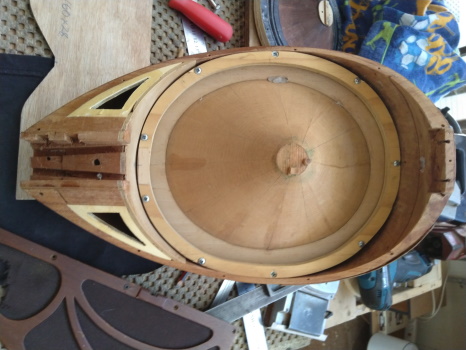4. Tarhu Soundhole Design
Peter Biffin September 2019
Disambiguation: in tarhu terminology, the term “soundhole” has the same meaning that it does in all bass-reflex acoustic structures – a vent that connects the airmass inside the chamber to the outside air. The term “soundhole” does not refer to the decorative perforations in the upper half of the body shell. These perforations do not have an acoustic function – they merely allow the structural integrity of the body to be maintained while allowing free passage of air around the cone. These holes form a “grill” design, not a “soundhole” design.
THE ACOUSTICS BACKGROUND
One of the features of the tarhu acoustic design is having a small body in relation to the lowest pitch required. A tarhu is able to produce strong low frequencies more because of the efficiency of the cone system, not because the sound produced by the cone is strongly reinforced by the vibrating air mass inside the body – the air mass is too small to do that effectively.
In the early years it was therefore a recurring question as to whether it was better for tarhus to have no hole at all. In contemporary loudspeaker cabinet design this approach is often taken – everywhere one sees very small speaker cabinets that are not vented with a soundhole.
The research leading up to the first tarhu indicated that having at least some bass reinforcement from a very small hole was better than none, and so in the first tarhu two small soundholes were positioned forward of the cone. This was made possible by the lute-shape of that instrument and, given all the design elements, was quite a reasonable solution.
When the spherical tarhus arrived in 1998, the soundhole became a problem, as the cone occupied all the available space in the upper section of the body. Placing a small circular hole in the cone itself was the very unattractive solution.
LONGNECK TARHU
Since 1998, a single hole in the cone has been used, the size of the hole depending on the size of the body. Earlier longneck tarhus used a 25 mm hole (in a 290 mm x 210 mm body) and more recently a 28 mm hole (in a 310 mm x 220 mm body), with the holes in both cases being reinforced with cross grain balsa 4 mm thick. These holes placed the air resonance around G#. When the bottom string is tuned to D (a tone above cello C), having the air resonance an augmented fourth above the lowest note is an optimal location……..so in that respect the hole is not so bad, it just felt dumb putting it in the cone. If the longneck tarhu was only being used as a bowed instrument, the most likely location for the hole would be in the middle of the back (as is now done in the smaller (largely bowed) tarhus). For plucking this never seemed to produce as good a result as the forward-facing hole-in-cone version. This needs further investigation.
KAMANCHEH TARHU AND SHAH KAMAN
Unlike the longneck tarhu, which had no closely related traditional instrument, the kamancheh tarhu/shahkaman had very strong connections. Traditional kamanchehs use no soundhole vent, and the absence of a hole has a significant bearing on their overall sound type. Because of this, early kamancheh tarhus likewise had no holes – initially the concern was that the presence of air resonance would push the sound into territory that was more unfamiliar to traditional kamancheh players. As familiarity with the kamancheh world increased, this concern seemed unfounded – by around 2006 a similar hole system to the one used in longneck tarhu was being used (with a balsa-reinforced 25 mm hole in the cone).
In 2012 a serendipitous event introduced the concept of a kamancheh tarhu with holes in the back of the body. During a cone experiment, a back was needed to tape on the body and the only body-half available was an upper half, which had grill-holes partly cut. When the front was taped on and used as a back, the result was instantly very interesting. This result completely took over the experiment that was being conducted, and every kamancheh tarhu/shahkaman since has had holes in the back of the body. With the arrival of this new system, holes were no longer placed in kamancheh tarhu cones.
Initially the soundholes cut in the back of the body had a comparatively large surface area – much, much bigger than the 25 mm soundhole used in the cone. The surface area was so large that it seemed the whole concept of bass reflex enclosure had been by-passed and replaced with……..no idea what. This “Don’t know what is happening but it works” approach continued for several years until time was finally found to start sorting it out.
In retrospect, this is an explanation for what was happening in that version: the large hole surface area placed the air resonance so high it was no longer recognisable. The lack of air-mass loading on the back side of the cone allowed it to respond in a different way that was very attractive and this change in how the cone functioned made up for the lack of bass reflex enclosure. However, the air mass was still operative at least to some extent – the sound was still much better with a back that had large holes compared to when there was no back at all.
In early 2019, the surface area of kamancheh tarhu back holes was explored in more detail and it was found that bass reflex rules do indeed still apply. The size of the holes was reduced till the air resonance was a major second above the lowest note ( using a kamancheh tarhu with bottom string tuned to violin G, air resonance on A). There was a strong wolf note around the A and the bass was quite strong above that point – ie, exactly what one would expect with an air resonance in that location. By the time the holes were enlarged and the air resonance moved up to C# (an augmented 4th above the lowest note) the wolf note associated with the air resonance had become quite manageable and the feel of the whole lower range was rich, powerful and smooth. As the air resonance was raised higher with bigger and bigger holes, the air resonance wolf note diminished and disappeared, the instrument’s sound remained smooth and attractive, but compared to the C# version, had lost strength in the lower register. On the basis of this experiment, hole size in kamancheh tarhu and shah kaman has now been focused on the C# air resonance target.
In 2019 an upgrade on an old kamancheh tarhu was carried out, which had a 25mm soundhole in the cone. Holes were added in the back until the combined surface area of cone-hole and back-holes placed the air resonance on C#. This was a very successful upgrade, but as yet there has not been an opportunity to check whether it is generally better to share the soundhole area between the front and the back, or better to only place holes in the back.
NB: Even though the soundholes carved into the back of a tarhu body follow the same design as the grill-holes cut in the front of the outer shell, the ones in the back are true soundholes - whereas the grill holes cut into the upper shell are not part of a tuned air resonance system.




